 klaus-michael schneider
klaus-michael schneider
Keywords: ecuador |
Links: FOTW homepage | search | disclaimer and copyright | write us | mirrors

Last modified: 2021-08-26 by  klaus-michael schneider
klaus-michael schneider
Keywords: ecuador |
Links: FOTW homepage |
search |
disclaimer and copyright |
write us |
mirrors
See also:
At www.mmrree.gov.ec
there is a government statement about the flag of Ecuador:
Historical synthesis of the flag - We can identify eight
periods in the history of Ecuador's flag:
1) The 1809 leaders raised a red flag with white mast against the
Spanish authorities. It fell in bloody Samano's hands in 1812.
(see: 1809 Flag)
2) A flag with five horizontal stripes BWBWB and three stars in
the middle stripe to symbolize Guayaquil, Portoviejo and Machala,
was raised by the patriots in the 9th October 1820 Liberation.
(see: 1820 Flag).
3) The previous flag changed by decree the 2nd June 1822:
"The flag of the free province of Guayaquil shall be white
and its first quarter blue with a centered star [no colour
indicated for the star]". (see: 1822 Flag).
4) The Colombian [horizontal] tricolour, which presided the
heroic deed of Pichincha and later on flied over the Tejar tower,
and the 25th May was officially hoisted on the Panecillo fort,
served as well as a sign of annexation of Guayaquil to Colombia
and became definitive. (see: Great
Colombia).
5) When Ecuador comes apart from Greater Colombia in 1830 it
keeps the previous flag. During the 1845 Marcista [March?]
Revolution the blue/white flag returns, now as a vertical
tricolour WBW, the blue stripe with stars. (see: March
1845 Flag).
6) The Cuenca Convention ratified by decree the 6th November 1845
the blue colour of Ecuador's skies , changing the three stars
into seven, "as symbols of the seven provinces which make up
the Republic". (see: 6 November 1845 Flag).
7) The Marcist flag lasted from 1845 to 1860. After Garcia
Moreno's victory over the forces of Castilla [a person, not
Castile] and Franco and the shameful Treaty of Mapasingue, he
orders that "The bicolour [Really - WBW tricolour] has been
shamed out of treason and bears a wash-proof stain. Let the old
Equadorian flag, sealed with heroes' blood, be forever
consecrated as the people's ensign and the pride of our national
glories".
8) The 1861 Convention confirmed this decree and it became
definitive in 1900, by decree of the Legislative. It is made up
of three colours Yellow Blue and Red in horizontal stripes, with
the yellow having double the width.
Santiago Dotor, 21 October 1998
This is an incomplete one. The patriots of Guayaquil raised a
white flag with a blue escutcheon with a white star on October
9th, 1820. This flag was kept in use possibly until 2 June 1822.
The five striped flag was introduced on October 11th, 1822,
expressively as Naval Ensign and War flag. On 2 June 1822 a white
flag with blue canton and a (white) star was hoisted as the flag
of Guayaquil. The people lowered the flag on 13 June and hoisted
the Colombian Y-B-R, which had been hoisted in Ecuador on 25th
May 1822. The Yellow-blue-red flag kept flying until 1845. Norie
(1848) by the way shows the flag of equal stripes without arms,
as did Laurie (1842). There were flags with arms. The Marxist
revolution brought the white-blue-white vertical flag. Introduced
on 7 March with three stars, changed to seven stars by decree of
6 November. Article 2 gives the national flag, article 3 the war
flag, naval ensign and fortress flag which has the coat of arms
in the lower part of the blue, the stars above. The fight between
several parties in Ecuador (end of the 1850s) led to four
Governments at the same time. One of them was in Guayaquil (the
Liberals), one in Quito (the Conservatives). Their flags are
known. The others are not, maybe one day we'll find out who had
the white-blue-red with six stars and who had the vertical
yellow-blue-red (which is reported by the historian RamĂłn
Aspurua in 1875 as the flag of the Quito government). In 1858
there were nine stars on the blue. By decree of 26 September 1860
Ecuador (now complete in the hands of the Quito government)
returned to the yellow-blue-red flag.
Ralf Stelter, 23 May 1999
I have a page from an old encyclopedia (I'm guessing from
around 1900) which shows numerous world flags. Included is a flag
of Ecuador--but one with which I am not familiar. It has three
vertical stripes (white-blue-white) with 7 white stars on the
blue stripe (6 surrounding one in the center). When did this flag
exist? What was its symbolism?
Paul Miller, 2 November 1996
The Sept. 1934 National Geo shows a version of this flag on
its "Flags Famous in American History" pages; W-B-W
vertical with the stars as you describe them in the upper part of
the blue and a coat of arms in the lower part. The coat of arms
appears to be pretty much the same as that used today, but with
different (white) flags around the shield. The text says
"When Ecuador was a part of the Republic of Columbia, it
used this standard."
Dave Martucci, 4 November 1996
My notes show that Ecuador used this as their national flag
from 1860 to 1900. My flag charts dated 1853, 1858, and 1863
(apparently Johnson's and Colton's Atlases were a bit slow to
update their flag plates) show the yellow/blue/red, but my charts
from 1870 on up to the turn of the century show the vertical
white/blue/white with stars. The 19th century editions of the
U.S. Navy's book "Flags of Maritime Nations" show the
white and blue flag as well. Unfortunately I do not have a copy
of the books by Preble (1872) or Hulme (1897) at my office to see
if either author tells us of the symbolism.
Flag 444 in the October 1917 National Geographic (which I *do*
happen to have handy) is the White - blue - white flag with seven
stars in the upper half of the blue band and the coat of arms
below it. The text for this flag reads: "This flag of
Ecuador when it was a part of the Republic of Colombia had as its
coat-of-arms a design which was very similar to that used at
present. The circle of seven [shown as a circle of six with one
in the middle] stars in the upper part of the blue stripe
represented the seven provinces of the republic"
Although we still don't know the meaning of the colors, it seems
that in 1860 Ecuador scrapped the yellow - blue - red flag it had
adopted after the break-up of Gran Columbia and used the white -
blue - white flag (without the coat of arms below the stars) it
had used while a member of GC.
I had an opportunity to purchase a 3'x5' wool example of the old
Ecuadorian flag many years ago but passed it by. The same antique
dealer had a Norwegian flag with the Union Mark in the canton
that I recognized as something special and I did buy that one.
Both flags were from an old store that rented costumes, etc, and
although undoubtedly U.S. made, the flags were from the late 19th
century.
Nick Artimovich, 4 November 1996
On 6 march 1845 Ecuador adopted a flag vertical
white-blue-white with on the blue strip three white stars,
increased to seven on 6 November, which was in use until 26
september 1860.
Source: "The world of flags" by William Crampton.
Mark Sensen, 4 November 1996
I looked that up in Crampton's book when I got home last night and was surprised when I read it. It quite contradicts what I posted yesterday. I also checked a few other of my 19th century flag books, and here is what I found for the flag of Ecuador:
All my charts prior to the 1860's show the yellow - blue -
red, as do those after 1900. Does anyone have their repro of
Norrie and Hobbs (1850 IIRC) handy? What do they show?
The information that Mark quoted from Crampton sounded authentic,
but it is hard to reconcile this with the illustrations found in
books and charts from the period. If Ecuador indeed adopted the
yellow - blue - red in 1860, then a number of very
"reliable" sources were wrong until the later 1870's
when most books show the yellow - blue - red. The fact that Hulme
shows the white - blue - white as late as 1897 is really hard to
figure.
Nick Artimovich, 5 November 1996
Nick Artimovich's flag charts may be right in what they show:
The 1853 and 1858 charts show the flag in use until 1845, and the
1863 chart shows the y-b-r of 1860. Norie (1848) and Laurie
(1842) show the y-b-r with equal stripes for Ecuador. Steenbergen
(about 1860) shows the w-b-w. The dates of those flags are
correct, as proved by decrees and laws.
Ralf Stelter, 23 May 1999
I found the same time range (i.e. 1845-1860) for the use of
the white-blue-white in "Flaggen und Wappen der Welt"
by K.H. Hesmer. But I don't know how independent all these flag
books are.
Since Ecuador was first using the yellow-blue-red (1830-1845)
then the white-blue-white (after some civil war [??] in 1845),
and eventually returned to the old pattern (for which reason ?)
it could be that rivaling factions used the two flags for some
time. But this is just blind guess.
Harald Muller, 5 November 1996
Harald Muller is quite right, as he can read above. There were
four fractions fighting for power in Ecuador and all four used
flags I assume. For sure the conservatives never agreed with the
liberals' w-b-w and they always flew the y-b-r flag.
Ralf Stelter, 23 May 1999
I checked a couple of my other books and those that have any detail do support the dates of :
Nick Artimovich, 7 November 1996
The short dates, as Nick Artimovich gave them, here corrected:
Ralf Stelter, 23 May 1999
The Ecuadorian flag is very similar to the Venezuelan and the
Colombian Flag. This happens because these three nations (under
the names of Guayaquil, Venezuela and Nueva Granada) formed, back
in the 1820s, the Great Colombia Republic
(GCR), and then adopted the Mirandinian-Venezuelan tricolor. The
ratio of this flag, however, differs from its sister flags: it's
1:2, whereas the Colombian and Venezuelan flags are 2:3.
During the 1820s, the three countries of the Great Colombia used
the tricolor with the GCR's Coat of Arms on it. After the split
of the late 1820s, they adopted their own Coat of Arms.
Guillermo Aveledo, 8 October 1999
At J.W Norie - J.S. Hobbs: Flaggen aller seefahrenden
Nationen, 1971[nor71] (original
print 1848):
281 Ecuador - yellow-blue-red with equal (fly-wise) stripes.
Peter Hans van den Muijzenberg, 12 November 2001
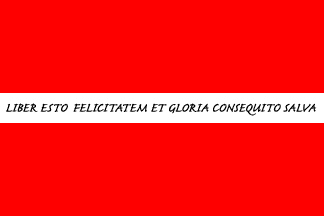 image by António Martins-Tuválkin, 18 November 2017
image by António Martins-Tuválkin, 18 November 2017
This flag hoisted by the patriot society in 1794. Plain red
flag was hoisted by the patriots 10 August 1809.
Jaume Ollé , 10 October 1999
It is a ~2:3 red flag with a thin horizontal white stripe centered on it, and
lettering on the stripe reading "Liber Esto Felicitatem et Gloria Consequito
Salva" in black cursive capitals.
António Martins-Tuválkin, 18 November
2017
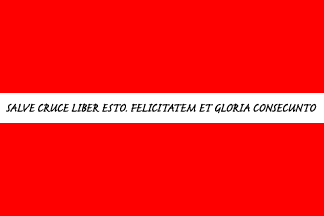 image by António Martins-Tuválkin, 18 November 2017
image by António Martins-Tuválkin, 18 November 2017
At http://www.elcomercio.com/blogs/la-silla-vacia/espejo-prototipo-ilustracion-teorico-educacion.html, an article by Fausto Segovia reports a different inscription: "Salve Cruce Liber Esto. Felicitatem et Gloria Consecunto", and explains that red flags with this subversive message showed up draping the crosses of some of the churches in Quito the morning of Oct. 21st, 1794, causing great commotion.
 image by Eugene Ipavec, 11 September 2006
image by Eugene Ipavec, 11 September 2006
On the 10 of August of 1809, independentists raised a red flag
on a white staff.
Source: www.ejercito.mil.ec.
E.R., 11 September 2006
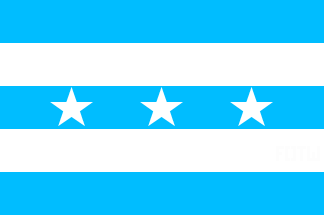 image by Jaume Ollé and Eugene Ipavec, 11
September 2006
image by Jaume Ollé and Eugene Ipavec, 11
September 2006
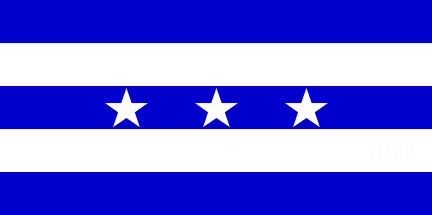 image by Eugene Ipavec, 11 September 2006
image by Eugene Ipavec, 11 September 2006
Ratio 2:3. Adopted: 11 October 1820. Abolished: 25 May 1822.
Jaume Ollé
Raised in Guayaquil during triumph of 1820. Three white
five-pointed stars symbolize Guayaquil, Machala and Fortoviejo.
Appear at the source as 1:2.
Source: www.ejercito.mil.ec.
E.R., 11 September 2006
.gif) image by Eugene Ipavec, 12 September 2006
image by Eugene Ipavec, 12 September 2006
First Coat of Arms which emerged after the 9 of October 1820
revolution. The inscription on the bottom ("POR GUAYAQUIL
INDEPENDIENTE") was added later.
Source: www.ejercito.mil.ec.
E.R., 12 September 2006
 image by António Martins-Tuválkin, 30 December 2017
image by António Martins-Tuválkin, 30 December 2017
This flag and March 1945 flag belong to
Ecuador's History, and are the original flags from which the November 1845 flag derives. The first one
substituted the Venezuelan-neogranadenian tricolor (flown early
that year [May 25th] in Quito), and was adopted by the Supreme
Junta of Guayaquil (now Ecuador) formed by Generals Olmedo, Roca
y Ximena (it should be noted that, during the Confederation of
the Great Colombia, Venezuela, Nueva Granada and Guayaquil used
their own flags as well as the Great Colombia flag). This flag
has a white field, and a sky-blue canton with a lone five-pointed
white star centered on it.
Guillermo Aveledo, 8 October 1999
Ecuador used a different flag from the tricolor from 1822
(when it was liberated; this flag was not very used during the
existence of the GCR, save only by ardent Ecuadorian
Nationalists): a 1:2 flag, white field, a light-blue canton with
a white five-pointed, star on its centre.
Guillermo Aveledo, 8 November 1999
.gif) image by Eugene Ipavec and Jaume Ollé, 12
September 2006
image by Eugene Ipavec and Jaume Ollé, 12
September 2006
When Ecuador became part of the nation usually called Great Colombia on May 29 1822, it adopted
this Coat of Arms, created on October 6, 1821. This is fairly
similar to Gran Colombia arms but
not quite the same.
Source: www.ejercito.mil.ec.
E.R., 12 September 2006
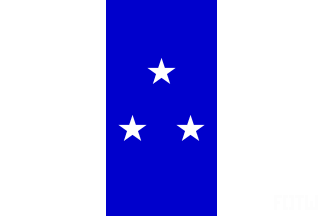 image by Eugene Ipavec, 11 September 2006
image by Eugene Ipavec, 11 September 2006
This 1822 flag gave way to two variations:
this first one was the flag which was adopted on March 6th, 1845.
This one adopted a vertical triband, of white/sky-blue/white,
with three five pointed, white stars forming a triangle, centered
on the blue, central, bar. Later that year, four more stars were
added, forming an alignment of seven stars making the November 1845 flag.
Guillermo Aveledo, 8 October 1999
After 1845, they adopted a similar flag: a vertical trocolor,
also 1:2, with a light blue stripe between two white, wider,
bands; the blue stripe had three (later seven) stars forming a
triangle on it. In 1860, Ecuador adopted the flag we know today.
Guillermo Aveledo, 9 October 1999
The tri-star one was adopted in March, 1845. The number of
stars rose to 7 later that year (November- see below). This flag
was used up to 1860, when the tricolor was reestablished as the
Ecuadorian flag.
Guillermo Aveledo, 4 November 1999
The three five-pointed white stars symbolizes the three
Departments in which Ecuador was divided at the time.
Source: www.ejercito.mil.ec.
E.R., 11 September 2006
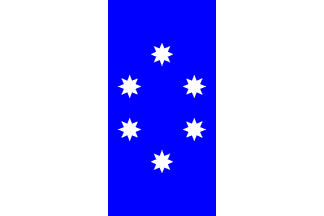 image by Željko Heimer, 1 August 2001
image by Željko Heimer, 1 August 2001
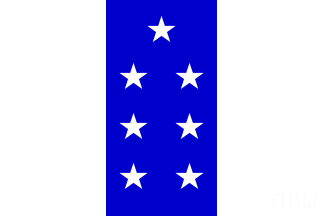 image by Eugene Ipavec, 11 September 2006
image by Eugene Ipavec, 11 September 2006
Znamirowski [zna99] on p. 118
gives civil ensign 1845-1860 as WBW vertical with 6 eight-pointed
stars. Here we have variants with 3 and 7 stars, though, but I
guess it was being variable. In any case, be it 6 or 7, I would
guess that not only civil ensign existed in those 15 years.
Željko Heimer, 1 August 2001
According to www.ejercito.mil.ec,
it had seven white five-pointed stars, not eight-pointed.
E.R., 11 September 2006
![[Ecuador - 1845]](../images/e/ec-1845b.gif) image by António Martins-Tuválkin, 27 July 2017
image by António Martins-Tuválkin, 27 July 2017
For my birthday, a friend got me a copy of "People's
Atlas of the World", published in April 1899 (almost exactly
100 years ago) by Mast, Crowell & Kirkpatrick of Springfield,
Ohio. The very first page is a color chart of "Flags of
Various Nations". There are 36 small flags. Many of them are
the same as current flags. Some of them are of complex designs
which have obviously been simplified to the point of some
features being uncertain. I can't vouch for the authenticity of
these flags. I can only report that they were published in this
atlas. This flag represented Ecuador.
Chris Young, 26 March 1999
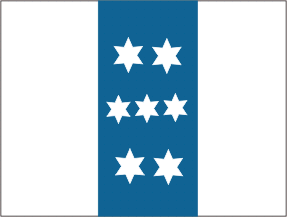 image by Jaume Ollé, 4 June 2003
image by Jaume Ollé, 4 June 2003
No. 642 - Ecuador.
Source: [stb62].
Jaume Ollé, 4 June 2003
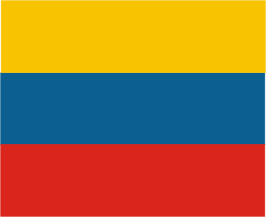 image by Jaume Ollé, 27 September 2003
image by Jaume Ollé, 27 September 2003
No. 1016 - Ecuador and Guayaquil.
Source: [stb62].
Jaume Ollé, 27 September 2003
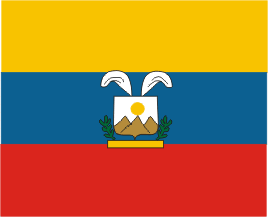 image by Jaume Ollé, 28 September 2003
image by Jaume Ollé, 28 September 2003
No. 1038 - Ecuador.
Source: [stb62].
Jaume Ollé, 28 September 2003
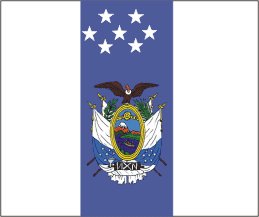 image by Jaume Ollé, 17 November 2003
image by Jaume Ollé, 17 November 2003
Addition No. 642a - Ecuador State.
Source: [stb62].
Jaume Ollé, 17 November 2003